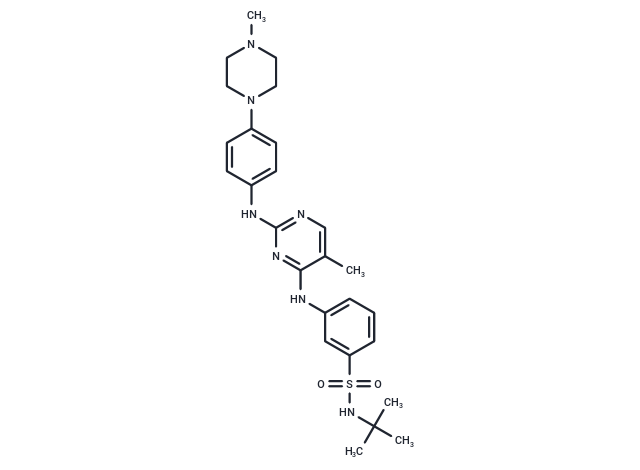Shopping Cart
Remove All Your shopping cart is currently empty
Your shopping cart is currently empty
TG101209 is a selective JAK2 inhibitor with an IC50 of 6 nM.

| Pack Size | Price | USA Warehouse | Global Warehouse | Quantity |
|---|---|---|---|---|
| 2 mg | $40 | In Stock | In Stock | |
| 5 mg | $61 | In Stock | In Stock | |
| 10 mg | $85 | In Stock | In Stock | |
| 25 mg | $108 | In Stock | In Stock | |
| 50 mg | $126 | In Stock | In Stock | |
| 100 mg | $207 | In Stock | In Stock | |
| 1 mL x 10 mM (in DMSO) | $67 | In Stock | In Stock |
| Description | TG101209 is a selective JAK2 inhibitor with an IC50 of 6 nM. |
| Targets&IC50 | JAK3:169 nM, RET:17 nM, JAK2:6 nM, FLT3:25 nM |
| In vitro | Compared to animals treated with a placebo, those administered TG101209 exhibited a significant reduction in the burden of circulating tumor cells in a dose-dependent manner, with a reduction ratio of up to 20% at +11 days. Administering 100 mg/kg of TG101209 effectively extended the survival time of animals afflicted with JAK2V617F-induced disease by 10 days. |
| In vivo | TG101209 inhibits survivin in HCC2429 and H460 lung cancer cells and reduces the phosphorylation of STAT3. It induces cell cycle arrest and apoptosis in acute myeloid leukemia cell lines expressing the human JAK2V617F mutation, while inhibiting the phosphorylation of JAK2V617F, STAT5, and STAT3. TG101209 suppresses the growth of Ba/F3 cells expressing the JAK2V617F or MPLW515L mutations, with an IC50 of approximately 200 nM. It inhibits the growth of hematopoietic colonies from progenitors carrying the JAK2V617F or MPL515 mutations. TG101209 significantly reduces the phosphorylation of STAT5 without affecting the total STAT5 protein level. It eliminates the phosphorylation of BCR-JAK2 and STAT5, reduces Bcl-xL expression, and induces apoptosis in transformed Ba/F3 cells. |
| Kinase Assay | Cell-free Kinase Activity Assays: IC50 values for TG101209 are determined using a luminescence-based kinase assay with recombinant JAK2, VEGFR2/KDR, and JAK3 obtained from Upstate Cell Signaling Solutions. Kinase reactions are carried out in a buffer consisting of 40 mM Tris buffer (pH 7.4), 50 mM MgCl2, 800?M EGTA, 350?M Triton X-100, 2?M ?-mercaptoethanol, 100?M peptide substrate, and an appropriate amount of JAK2, VEGFR2/KDR or JAK3 such that the assay is linear over 60 minutes. The reaction is initiated by the addition of 10?L of ATP to a final concentration of 3 mM and terminated by the addition of Kinase-Glo reagent after 60 minutes. Luciferase activity is quantified using an Ultra 384 instrument set for luminosity measurements. IC50 values are derived from experimental data using the non-linear curve fitting capabilities of the GraphPad Prism 4.0 software. The single concentration inhibition data for a panel of 63 kinases is determined using the SelectScreen TM service. |
| Cell Research | In brief, approximately 2 × 103 cells are plated into microtiterplate wells in 100 ml RPMI-1640 growth media with indicated concentrations of TG101209. The relative growth of cells is quantified at 24-hour intervals using Cell Proliferation Kit II (XTT) as per manufacturer's guidelines. After incubation, 20 mL of XTT is added to the wells and allowed to incubate for 4-6 hours. The colored formazan product is measured spectrophotometrically at 450 nm with correction at 650 nm, and IC50 values are determined using the GraphPad Prism 4.0 software. Data are subjected to a non-linear regression-fit analysis and IC50 values are determined as the concentration that inhibited proliferation by 50%. All experiments are done in triplicate and the results normalized to growth of untreated cells.(Only for Reference) |
| Molecular Weight | 509.67 |
| Formula | C26H35N7O2S |
| Cas No. | 936091-14-4 |
| Smiles | CN1CCN(CC1)c1ccc(Nc2ncc(C)c(Nc3cccc(c3)S(=O)(=O)NC(C)(C)C)n2)cc1 |
| Relative Density. | 1.250 g/cm3 |
| Storage | Powder: -20°C for 3 years | In solvent: -80°C for 1 year | Shipping with blue ice/Shipping at ambient temperature. | |||||||||||||||||||||||||||||||||||
| Solubility Information | DMSO: 94 mg/mL (184.43 mM), Sonication is recommended. Ethanol: < 1 mg/mL (insoluble or slightly soluble) H2O: < 1 mg/mL (insoluble or slightly soluble) | |||||||||||||||||||||||||||||||||||
| In Vivo Formulation | 10% DMSO+40% PEG300+5% Tween 80+45% Saline: 3.3 mg/mL (6.47 mM), Sonication is recommended. Please add the solvents sequentially, clarifying the solution as much as possible before adding the next one. Dissolve by heating and/or sonication if necessary. Working solution is recommended to be prepared and used immediately. The formulation provided above is for reference purposes only. In vivo formulations may vary and should be modified based on specific experimental conditions. | |||||||||||||||||||||||||||||||||||
Solution Preparation Table | ||||||||||||||||||||||||||||||||||||
DMSO
| ||||||||||||||||||||||||||||||||||||
| Size | Quantity | Unit Price | Amount | Operation |
|---|

Copyright © 2015-2025 TargetMol Chemicals Inc. All Rights Reserved.